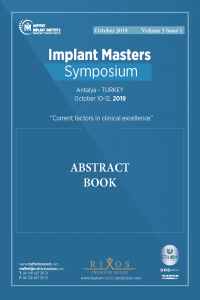Abstract
Introduction: Dental implants are widely used to replace lost teeth. It is suggested that surgical manipulation/augmentation of peri‐implant soft tissue may be beneficial to increase the width/thickness of keratinized gingiva (KG). For dental implant therapy, reconstruction of the alveolar bone through a variety of regenerative surgical procedures has become predictable. In this case, we present soft tissue management of the edentulus area, horizontal augmentation of the athropic alveolar ridge via an autogenous block graft(ABG) harvested from the mandibular region and implant placement. Case Report: A 52-year old female patient referred to our denrtal clinic because of teeth loss in the left lateral region of the lower jaw. Clinical examination revealed thin, insufficient KG and pronounced horizontal resorption of the residual alveolar ridge. After clinical examination we performed a free gingival graft operation (FGGO). 6 weeks later, horizontal bone augmentation through mandibular bone block graft harvested from retromolar region was performed at atrophıc area. The actual site was grafted with a mixture of autogenous and xenograft and covered by membrane. Six months after transverse ridge dimensions were found to be enhanced nearly 4 mm and 2 implants were placed succesfully. Discussion & Conclusion: Dental implants with less than 2 mm of KG seem to be more prone to recession and alveolar bone loss. Severe resorption of alveolar bone can make implant insertion challenging due to inadequate bone volume and/or abnormal morphology. For the placement of implants, there should be at least 1.5 mm of bone on the facial aspect and 0.5 mm on the palatal aspect. The present case of collapsed alveolar ridge with adequate vertical height was suitable for ABG and (FGGO). For successful implant treatment, both soft tissue and hard tissue should be in optimal conditions. Keywords: Soft tissue management.
Keywords
References
- .
Details
| Primary Language | English |
|---|---|
| Subjects | Dentistry |
| Journal Section | Articles |
| Authors | |
| Publication Date | October 13, 2019 |
| Published in Issue | Year 2019 Volume: 3 Issue: 1 |


